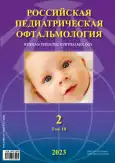Girate atrophy: clinical and functional features
- Authors: Kogoleva L.V.1, Zolnikova I.V.1, Kokoeva N.S.1, Bobrovskaya J.A.1, Milash S.V.1
-
Affiliations:
- Helmholtz National Medical Research Center of Eye Diseases
- Issue: Vol 18, No 2 (2023)
- Pages: 75-82
- Section: Case reports
- URL: https://journal-vniispk.ru/1993-1859/article/view/148254
- DOI: https://doi.org/10.17816/rpoj567804
- ID: 148254
Cite item
Abstract
Gyrate atrophy is a rare genetic metabolic disease with an autosomal recessive inheritance that causes progressive chorioretinal atrophy, fundus manifestations, and decreased visual function. The prognosis of the disease largely depends on the development and progression of complications (macular changes and cataracts) as well as concomitant neurological and somatic pathology.
AIM: To describe three clinical cases of hypertension.
MATERIAL AND METHODS: We examined three children with gyrate atrophy at 4, 10, and 15 years old. All patients underwent a comprehensive ophthalmological examination, including modern diagnostics, visualization, and electrophysiological studies.
RESULTS: Although older patients have more pronounced changes in the fundus with involvement of the macular zone in the pathological process, a 4-year-old child has pronounced functional retinal disorders detected during electroretinogram registration, indicating an earlier manifestation of the pathological process. Gyrate atrophy was combined with foveoschisis and ornithinemia in older patients (10 and 15 years old).
The differential diagnosis of gyrate atrophy should be carried out with high myopia with areas of dystrophy of the “cobblestone pavement” type on the periphery of the fundus, resembling foci of chorioretinal changes in hypertension.
CONCLUSION: Patients with gyrate atrophy require an interdisciplinary approach that includes not only ophthalmologists but also pediatricians, medical geneticists, and other specialists with comorbidities.
Full Text
##article.viewOnOriginalSite##About the authors
Ludmila V. Kogoleva
Helmholtz National Medical Research Center of Eye Diseases
Email: ninoofta@mail.ru
ORCID iD: 0000-0002-2768-0443
SPIN-code: 2241-7757
MD, Dr. Sci. (Med.)
Russian Federation, 14/19, Sadovaya Chernogryazskaya Street, 105062, MoscowInna V. Zolnikova
Helmholtz National Medical Research Center of Eye Diseases
Email: ninoofta@mail.ru
ORCID iD: 0000-0001-7264-396X
SPIN-code: 2785-5060
MD, Dr. Sci. (Med.)
Russian Federation, 14/19, Sadovaya Chernogryazskaya Street, 105062, MoscowNina Sh. Kokoeva
Helmholtz National Medical Research Center of Eye Diseases
Author for correspondence.
Email: ninoofta@mail.ru
ORCID iD: 0000-0003-2927-4446
MD, ophthalmologist
Russian Federation, 14/19, Sadovaya Chernogryazskaya Street, 105062, MoscowJulia A. Bobrovskaya
Helmholtz National Medical Research Center of Eye Diseases
Email: ninoofta@mail.ru
ORCID iD: 0000-0001-9855-2345
MD, ophthalmologist
Russian Federation, 14/19, Sadovaya Chernogryazskaya Street, 105062, MoscowSergey V. Milash
Helmholtz National Medical Research Center of Eye Diseases
Email: ninoofta@mail.ru
ORCID iD: 0000-0002-3553-9896
SPIN-code: 5224-4319
MD, Cand. Sci. (Med.)
Russian Federation, 14/19, Sadovaya Chernogryazskaya Street, 105062, MoscowReferences
- RetNet [Internet]. Houston, Texas: Retinal Information Network [cited 2023 Jun 10]. Available from: http://sph.uth.edu/retnet/
- Jacobsohn E. Ein fall von Retinitis pigmentosa atypica. Klin Monatsbl Augenheilkd. 1888;26:202–206.
- Cutler CW. Drei ungewöhnliche Fälle von Retino-Chorio ideal-Degeneration. Arch Augenheilk. 1895;30:117–122.
- Montioli R, Bellezza I, Desbats MA, et al. Deficit of human ornithine aminotransferase in gyrate atrophy: Molecular, cellular, and clinical aspects. Biochim Biophys Acta Proteins Proteom. 2021;1869(1):140555. doi: 10.1016/j.bbapap.2020.140555
- Takki KK, Milton RC. The natural history of gyrate atrophy of the choroid and retina. Ophthalmology. 1981;88(4):292–301. doi: 10.1016/s0161-6420(81)35031-3
- Zolnikova IV, Milash SV, Zinchenko RA, et al. Gyrate atrophy of the choroid and retina with ornithinemia and foveoschisis (clinical observation). Vestnik Oftalmologii. 2022;138(5):80–86. (In Russ). doi: 10.17116/oftalma202213805180
- Elnahry AG, Tripathy K. Gyrate atrophy of the choroid and retina [Internet]. Treasure Island (FL): StatPearls Publishing; 2023 [cited 2023 Jun 10]. Available from: https://www.ncbi.nlm.nih.gov/books/NBK557759/
- Valtonen M, Nanto-Salonen K, Jaaskelainen S, et al. Central nervous system involvement in gyrate atrophy of the choroid and retina with hyperornithinaemia. J Inherit Metab Dis. 1999;22(8):855–866. doi: 10.1023/a:1005602405349
- Wilson DJ, Weleber RG, Green WR. Ocular clinicopathologic study of gyrate atrophy. Am J Ophthalmol. 1991;111(1):24–33. doi: 10.1016/s0002-9394(14)76892-8
- Balfoort ВМ, Buijs MJN, Anneloor LMA, et al. А review of treatment modalities in gyrate atrophy of the choroid and retina (GACR). Mol Genet Metab. 2021;134(1–2):96–116. doi: 10.1016/j.ymgme.2021.07.010
- Guseva MR, Astasheva IB, Khatsenko IE, Bezenina EV. A case of diagnosis of gyrate atrophy in infancy. Vestnik Oftalmologii. 2010;126(4):56–58. (In Russ).
- Chien JY, Huang SP. Gene therapy in hereditary retinal dystrophy. Tzu Chi Med J. 2022;34(4):367–372. doi: 10.4103/tcmj.tcmj_78_22
- Maldonado R, Jalil S, Keskinen T, et al. CRISPR correction of the Finnish ornithine delta-aminotransferase mutation restores metabolic homeostasis in iPSC from patients with gyrate atrophy. Mol Genet Metab Rep. 2022;31:100863. doi: 10.1016/j.ymgmr.2022.100863.
Supplementary files







